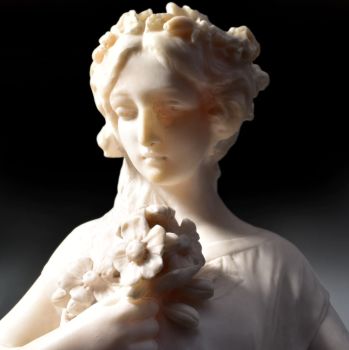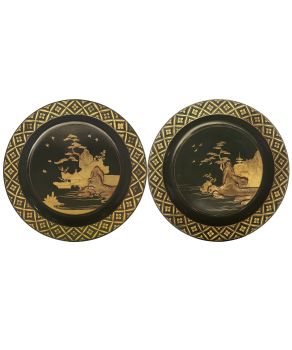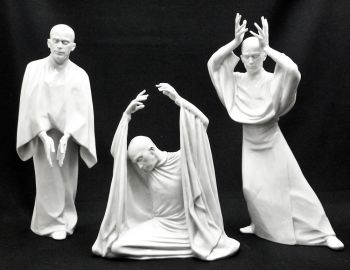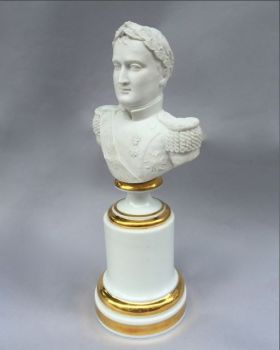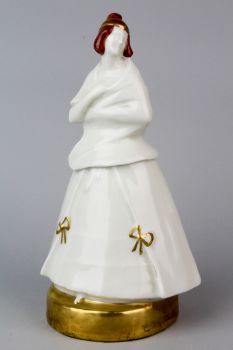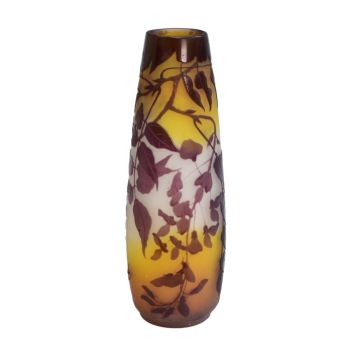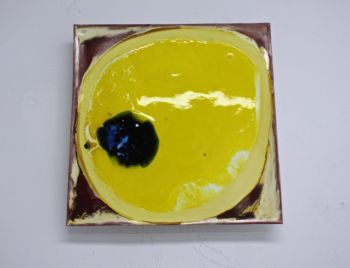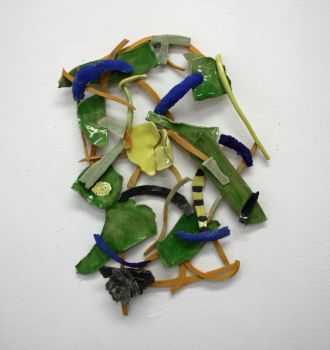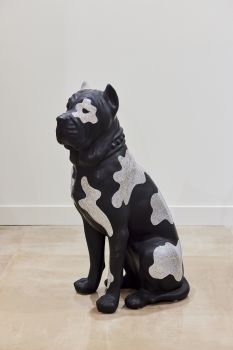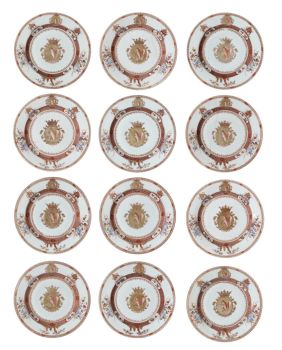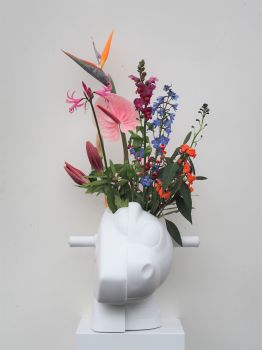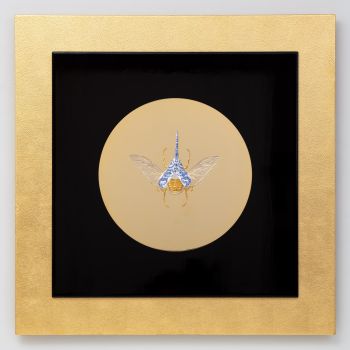Japanese porcelain blue and white ‘Van Frytom’ tea bowls and saucer dishes, Edo period, c. 1690-1710 1690 - 1710
Artiste Inconnu
Porcelaine japonaisePorcelaine
3.40 cm, ø 13 cm
ConditionVery good
Prix sur demande
Menken Works of Art
- Sur l'oeuvre d'artA set of seven ‘Van Frytom’ tea bowls and saucer dishes.
Japan, Arita, Edo period, c. 1690-1710.
The rare set consisting of three tea bowls and four saucer dishes with matching decorations in underglaze blue in the style of Dutch Delft painter Frederik van Frytom.
The bowls with spreading sides and everted rim, decorated in underglaze blue, on the outer body with a Frysian “kop-staart-rompboerderij” (translation: Head-Neck-Body farmhouse) and two figures standing next to each other in a landscape, the inner and outer rim with washed-blue bands. The well on the inside decorated with a figure standing in the grass with trees and a house. A typical stylized four-character Chenghua mark to the base.
The dishes in the form of a flower with foliated rim. Decorated in underglaze blue, similar to the bowls, with a Frysian “kop-staart-rompboerderij” and two figures standing next to each other in a landscape with grass, trees and clouds in the sky. The inner rim with a washed-blue band, the base with spur marks and a six-character Chenghua mark.
Ref:
A.Vecht, Frederik van Frytom 1632-1702, Life and work of a Delft pottery decorator, No. 40-44.
A pair of ‘Van Frytom’ style tea bowls are in the Metropolitan Museum of Art collection, accession number 2002.447.118 and accession number 2002.447.119. These are also illustrated in Japanese Art from the Gerry Collection in the Metropolitan Museum of Art, p. 116, pl. 95a,b.
For another tea bowl with this design, see: The Burghley Porcelains, An Exhibition from The Burghley House Collection, pp. 158-159, pl. 54.
A similar saucer dish is in the collection of The Burghley House, reference: CER0473
For a tea bowl and saucer dish of the same style but with a river scene, see the Twickel Castle collection, Delden, no. JK 13, illustrated in: Fine and Curious (Christiaan J.A. Jörg) pp. 244-246, pl. 317-317a.
Two similar dishes were also sold at Christie’s, 19 Dec 2014, lot 85.
Dimensions:
Bowls: Diameter 7.4 cm, height 3.4 cm.
Saucer dishes: Diameter 13 cm, height 2.5 cm.
Condition:
Very good condition, without damages.
Worldwide registered and insured shipping.
Take a look at our other listings for more Asian art and antiques.
Inv. No: MW107 - Sur l'artiste
Il peut arriver qu'un artiste ou un créateur soit inconnu.
Certaines œuvres ne doivent pas être déterminées par qui elles sont faites ou elles sont faites par (un groupe d') artisans. Les exemples sont des statues de l'Antiquité, des meubles, des miroirs ou des signatures qui ne sont pas claires ou lisibles, mais aussi certaines œuvres ne sont pas signées du tout.
Vous pouvez également trouver la description suivante :
•"Attribué à …." A leur avis probablement une oeuvre de l'artiste, au moins en partie
•« Atelier de …. ou « Atelier de » À leur avis, une œuvre exécutée dans l'atelier ou l'atelier de l'artiste, éventuellement sous sa direction
•« Cercle de… ». A leur avis une oeuvre de la période de l'artiste témoignant de son influence, étroitement associée à l'artiste mais pas forcément son élève
•« Style de … ». ou "Suiveur de ...." Selon eux, une œuvre exécutée dans le style de l'artiste mais pas nécessairement par un élève ; peut être contemporain ou presque contemporain
•« Manière de… ». A leur avis une oeuvre dans le style de l'artiste mais d'une date plus tardive
•"Après …." A leur avis une copie (quelle qu'en soit la date) d'une oeuvre de l'artiste
•« Signé… », « Daté… ». ou « Inscrit » À leur avis, l'œuvre a été signée/datée/inscrite par l'artiste. L'ajout d'un point d'interrogation indique un élément de doute
• "Avec signature ….", "Avec date ….", "Avec inscription …." ou "Porte signature/date/inscription" à leur avis la signature/date/inscription a été ajoutée par quelqu'un d'autre que l'artiste
Êtes-vous intéressé par l'achat de cette oeuvre?
Artwork details
Related artworks
- 1 - 4 / 12
Onbekende Kunstenaar
AN IVORY NETSUKE OF A DUTCHMAN FROLICKING WITH A SMALL BOY18th century
Prijs op aanvraagZebregs & Röell - Fine Art - Antiques
Onbekende Kunstenaar
A SMALL IVORY NETSUKE OF A DUTCHMAN WITH A DRUM1750 - 1800
Prijs op aanvraagZebregs & Röell - Fine Art - Antiques
Onbekende Kunstenaar
A rare Japanese export lacquer medical instrument box1650 - 1700
Prijs op aanvraagZebregs & Röell - Fine Art - Antiques
Onbekende Kunstenaar
EEN JAPANSE KLEINE SAWASA 'PERZIK-VORMIGE' KROESKOPearly 18th
Prijs op aanvraagZebregs & Röell - Fine Art - Antiques
Onbekende Kunstenaar
A RARE LARGE JAPANESE LACQUERED LEATHER TELESCOPE1750 - 1800
Prijs op aanvraagZebregs & Röell - Fine Art - Antiques
Onbekende Kunstenaar
The Stamford Raffles Secretaires.1800 - 1813
Prijs op aanvraagZebregs & Röell - Fine Art - Antiques
Onbekende Kunstenaar
EEN IVOREN NETSUKE VAN EEN NEDERLANDER MET EEN HAAN18th century
Prijs op aanvraagZebregs & Röell - Fine Art - Antiques
Onbekende Kunstenaar
A Japanese bronze Hu flower vase, Edo / Meiji, 19th century19th century
Prijs op aanvraagMenken Works of Art
1 - 4 / 22- 1 - 4 / 24
Onbekende Kunstenaar
A large Japanese Imari porcelain 'VOC Groningen' dish1800 - 1925
Prijs op aanvraagZebregs & Röell - Fine Art - Antiques
Samuel Dejong
Anatomia Blue Heritage, Hercules Open2017 - 2019
Prijs op aanvraagVilla del Arte Galleries
 Gecureerd door
Gecureerd doorGallerease Magazine
Samuel Dejong
Anatomia Blue heritage II Goliath Beetle closed BGG2019
Prijs op aanvraagVilla del Arte Galleries
1 - 4 / 24Onbekende Kunstenaar
Chinese gilt bronze censer, Xuande mark, 18th century, Qing dynasty18th century
Prijs op aanvraagMenken Works of Art
Onbekende Kunstenaar
A Japanese bronze Hu flower vase, Edo / Meiji, 19th century19th century
Prijs op aanvraagMenken Works of Art
1 - 4 / 12




















